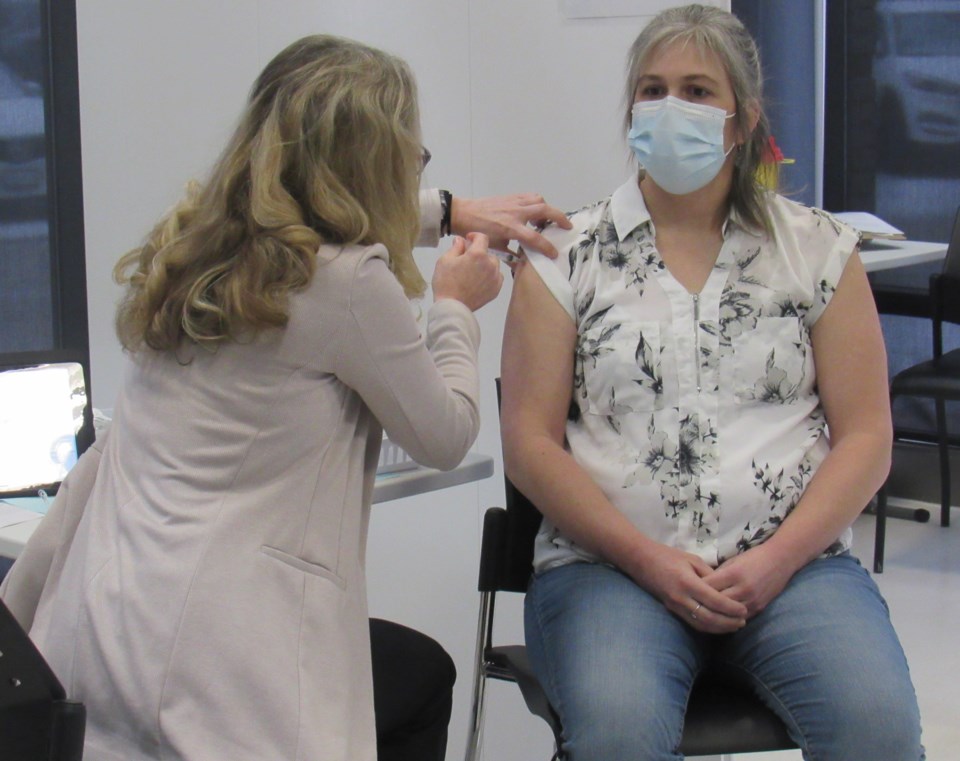The arrival of the COVID-19 vaccine to Simcoe-Muskoka brings hope that the region's most vulnerable population could soon be immunized.
As we reported earlier today, a Barrie PSW was the first in the region to receive the vaccine during a morning media conference. Click here to read that story.
“It’s the very beginning of the campaign that will carry through for most of next year, I anticipate, as we get more and more vaccines,” said Simcoe Muskoka District Health Unit medical officer of health Dr. Charles Gardner.
The ability to get this first vaccine distributed is limited, however.
The Pfizer-BioNTech COVID-19 mRNA vaccine must be stored at -70C or colder and is considered fragile. As a result, local officials decided to first focus on a mobile group who are able to go to the Sperling Drive satellite facility for the Royal Victoria Regional Health Centre.
In this very early stage in Ontario, immunizing health-care workers and essential caregivers is the priority.
But the Moderna COVID-19 vaccine is believed to be very close to receiving approval in Canada.
Gardner hopes the Moderna product, which requires storage at 20C and has a better shelf life, can be taken to long-term care and retirement homes, hospitals and potentially home care and be administered by qualified people on site.
“What we intend to do is establish liaison connections with our staff, our nursing staff, to those facilities and have the vaccine shipped to them and have personnel at those facilities administer the vaccine to the residents and to the staff,” he said during a media briefing Tuesday afternoon.
For the homes that can’t administer it, the health unit is looking to partner with local emergency services to help out.
“All of this has happened earlier than any of us have anticipated,” he said. “To have it available now has been a great blessing but also a great challenge.”
Although Tuesday was a day of celebration, he warned that commitments to protect against the spread of the deadly virus needs to double as the province begins a month-long shutdown on Boxing Day.
The provincial government has established a three-phase plan aimed to get most of the province immunized within a year or sooner. The priority is those who are more vulnerable or at higher risk of infection and serious illness in the early stages.
Gardner pointed out that more than half the deaths here and elsewhere are attributed to the elderly living in long-term care homes.
Simcoe-Muskoka was among the 17 communities to receive the initial doses. Just how many have arrived, where they’re being stored and when the next shipment is expected is being kept under wraps.
When more vaccines are approved for use in Canada, they will be more widely available.
After health-care workers, residents in long-term care homes and retirement homes, home-care patients with chronic conditions and Indigenous communities are immunized it will be made available to the general public.
Local supply chain expert David Johnston said that the operational concerns can be limited by not just the availability of the vaccine itself, but also the resources that can be accessed for its distribution across Simcoe-Muskoka.
“You want this dispensed as soon as possible,” said Johnston, director for the George Weston Ltd. Centre for Sustainable Supply Chains at York University, “because the sooner the people are vaccinated, the higher the probability that they are going to survive this without a positive test result.
“My guess is when you do that calculation (of the time it takes to vaccinate someone times the number of doses on hand), you’re going to run out of this batch of product very quickly long before it’s under any threat of expiry or contamination.”
Gardner explained that the Pfizer-BioNTech vaccine arrives packed cold in a deep freeze with the help of dry ice and there is a technical protocol to check it when it arrives to ensure the cold chain of transmission was never broken.
Trained pharmacy personnel at RVH place it in a deep freeze unit that has continuous temperature monitoring at a preferred temperature of -75C.
Prior to its use it is taken out of the freezer to be thawed over three hours and can be stored in that stage refrigerated for up to five days. At room temperature it’s good for two hours. But when a saline solution is added it’s then good for six hours.
“We don’t want to waste any of this vaccine, so there’s a great deal of effort put into being precise about how much vaccine is brought out to be used,” Gardner said. “It’s a very elaborate process, it took a great deal of work to set it up in the first place.”
Those who receive it have been pre-booked through a process managed by the hospital and are brought to the facility where safety protocol has been maintained. After they’re vaccinated they go to an after-care space where they are monitored for 15 minutes.
Before leaving, the vaccinated person is given a booking for the second shot in 21 days.
Johnston expects there will be obstacles when it comes time to vaccinate the entire population.
Adding to the cycle time by going to other sites requires increased resources and takes from the ability to inoculate more people. It also increases the chances of something going wrong. That all puts a heavier reliance upon the number of people required.
The most efficient approach, he said, is to have it available in one facility where people can enter or drive through, as was done in Korea.
“The less motion and the less movement by the actual health-care provider … the better it’s going to be,” he said.
To mass vaccinate a population quickly, a large supply is required with efficient use of an already strained resource - health-care professionals - to dispense it, he said.
